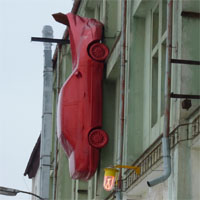
Mobilità sostenibile a Lione: dovremmo impiccare gli automobilisti?
Abstract
The second main issue of this conceptual framework deals with rationalities of user’s mobility practices. The axiological rationality (Boudon 1995) seems to be heuristic to question values and practices, searching for the rationale behind the conclusions that users draw when making mobility decisions (for example “the car is faster in my situation”). This justification process needs to be finely analyzed in combination with several concepts, norms and values that “make sense” for the individual. We propose the hypothesis that the combination of perception biases and axiological rationalities could helps to explain behaviors defined as “irrational” for urban mobility planners and to delineate the major levers of social acceptation and adoption of so-called sustainable urban environments.
Keyword
Full Text
PDF (English)Riferimenti bibliografici
Ascher F. (2004). Les sens du mouvement: modernités et mobilités. In S. Allemand, F. Ascher &
Levy J. (Eds.), Les sens du mouvement (pp. 19-21). Belin.
Bonneville M. (1997): Lyon. Métropole régionale ou euro-cité?, Editions Anthropos.
Boudon R. (1995) Sens et raison: théorie de l’argumentation et sciences sociales, Hermès, pp. 29-43.
CERTU (2009): Contraintes de stationnement et pratiques modales. Méthodologie et étude des cas de Lille, Lyon et Montpellier.
Choay F. (2004): Espacements. L’évolution de l’espace urbain en France.
De Certeau M. (1990): L’invention du quotidien, tome 1: Arts de faire. Gallimard.
Dupuy G. (1995): Les territoires de l’automobile. Editions Anthropos.
Haumont A. (2006). Le droit à la mobilité : vers un cadre contractuel renouvelé?, In M. Bonnet & P. Aubertel (Eds.), La ville aux limites de la mobilité (pp. 47-58). Presses Universitaires de France.
Héran F. (2001): La réduction de la dépendance automobile. Cahiers Lillois d’Economie et de Sociologie, 37, 61-86.
Hubert J. (2009) Dans les grandes agglomérations, la mobilité quotidienne des habitants diminue, et elle augmente ailleurs, INSEE Première, issue 1252
Illich I. (1973a): Energie et Equité. Editions du Seuil.
Illich I. (1973b): La convivialité. Editions du Seuil.
Kaplan D. & Marzloff, B. (2009): Pour une mobilité plus libre et plus durable. FYP éditions.
Kaufmann V. (2002) Temps et pratiques modales, le plus court est-il le mieux. Perception of time and modal choice. Is quickest best? Recherche Transports Sécurité (75), pp.131-143
Lefèbvre H. (1968): Le droit à la ville, suivi d’Espace et Politique. Ed. Anthropos.
Lefèvre C. & Offner, J. (1990): Les transports urbains en question: usages, décisions, territoires. Celce.
Mathon S. (2008): Le stationnement résidentiel sur l’espace public. Etat des lieux, problèmes et perspectives. Une application à l’agglomération lilloise, 465 p.
Polanyi K. (1944): La grande transformation. Aux origines politiques et économiques de notre temps. Gallimard.
Simondon G. (1958): Du mode d’existence des objets techniques. Editions Aubier.
Toussaint J-Y. (2003) Projets et usages urbains. Fabriquer et utiliser les dispositifs techniques et spatiaux de l’urbain, 248 p.
Vareilles S. (2006): Les dispositifs de concertation des espaces publics lyonnais. Eléments pour une analyse du rôle de la concertation des publics urbains dans la fabrication de la ville., Thèse de doctorat, Institut National des Sciences Appliquées, Lyon.
Viard J. (2006): Eloge de la mobilité - Essai sur le capital temps libre et la valeur travail. Editions de l’Aube
DOI: http://dx.doi.org/10.6092%2F1970-9870%2F497
Refback
- Non ci sono refbacks, per ora.

This work is licensed under a Creative Commons Attribution 3.0 License.



